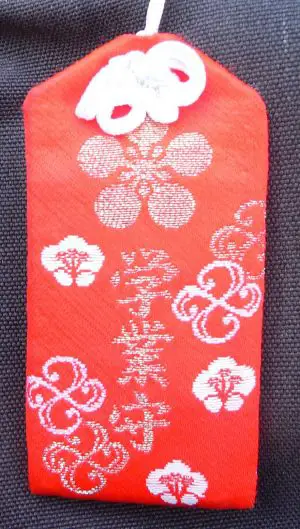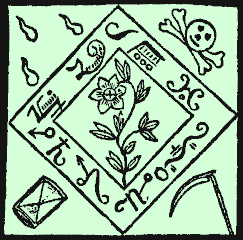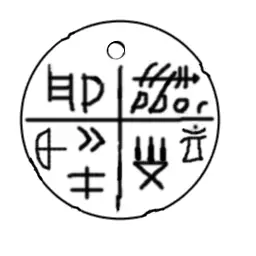Amulet
- AMULET is also an ARM asynchronous microprocessor.
An amulet (from Latin amuletum; earliest extant use in Natural History [Pliny], meaning "an object that protects a person from trouble") or a talisman (from Arabic tilasm, ultimately from Greek telesma or from the Greek word "talein" which means "to initiate into the mysteries.") consists of any object intended to bring good luck and/or protection to its owner. Potential amulets include: gems or simple stones, statues, coins, drawings, pendants, rings, plants, animals, etc.; even words said in certain occasions – for example: vade retro satana – (Latin, "go back, Satan"), to repel evil or bad luck.
Amulets and talismans in folklore
{{#invoke:Message box|ambox}} Amulets and talismans vary considerably according to their time and place of origin. In many societies, religious objects serve as amulets. A religious amulet might be the figure of a god or simply some symbol representing the deity (such as the cross for Christians or the "eye of Horus" for the ancient Egyptians). In Thailand one can commonly see people with more than one Buddha hanging from their necks; in Bolivia and some places in Argentina the god Ekeko furnishes a standard amulet, to whom one should offer at least one banknote to obtain fortune and welfare.
Every zodiacal sign corresponds to a gem that acts as an amulet, but these stones vary according to different traditions.
An ancient tradition in China involves capturing a cricket alive and keeping it in an osier box to attract good luck (this tradition extended to the Philippines). Chinese may also spread coins on the floor to attract money; rice also has a reputation as a carrier of good fortune.
Turtles and cactus can cause controversy, for while some people consider them beneficial, others think they delay everything in the house.
Since the Middle Ages in Western culture pentagrams have had a reputation as amulets to attract money, love, etc; and to protect against envy, misfortune, and other disgraces. Other symbols, such as magic squares, angelic signatures and qabalistic signs have been employed to a variety of ends, both benign and malicious.
The Jewish tradition is quite fascinating; examples of Solomon era amulets exist in many museums. Due to proscription of idols, Jewish amulets emphasize text and names - the shape, material or color of an amulet makes no difference.[1] [2] See also Khamsa.
The Jewish tallis (Yiddish-Hebrew form; plural is talleisim), the prayer shawl with fringed corners and knotted tassels at each corner, is perhaps one of the world's oldest and most used talismanic objects. Originally intended to distinguish the Jews from pagans, the prayer shawl is considered fascinating because of its name: it is very close to the term "talisman."[3]
In antiquity and the Middle Ages, most Jews, Christians and Muslims in the Orient believed in the protective and healing power of amulets and talismans. Talismans used by these peoples can be broken down into three main categories. The first are the types carried or worn on the body. The second version of a talisman is one which is hung upon the bed of an infirm person. The last classification of talisman is one with medicinal qualities. This latter category of magical item can be further divided into external and internal. In the former, one could, for example, place a magical amulet in a bath. The power of the amulet would be understood to be transmitted to the water, and thus to the bather. In the latter, magical inscriptions would be written or inscribed onto food, which was then boiled. The resulting broth, when consumed, would transfer the healing and magical qualities engraved on the food into the consumer.
There is also evidence that Jews, Christians, and Muslims used their holy books in a talisman-like manner in grave situations. For example, a bed-ridden and seriously ill person would have a holy book placed under part of the bed or cushion.[4]
Christian authorities have always been wary of amulets and other talismans.[5]
A little-known but well-worn amulet in the Jewish tradition is the kimiyah or "angel text". This consists of names of angels or Torah passages written on parchment squares by rabbinical scribes. The parchment is then placed in an ornate silver case and worn someplace on the body.[6]
The similarities between Jewish and Buddhist amulet traditions is striking. (see Buddhism below.)
In Afro-Caribbean syncretic religions like Voodoo, Umbanda, Quimbanda and Santería, drawings are also used as amulets, such as with the veves of Voodoo; these religions also take into account the colour of the candles they light, because each colour features a different effect of attraction or repulsion.
Perfumes and essences (like incense, myrrh, etc.) also serve the purposes of attraction or repulsion. Popular legends often attributed magical powers to certain unusual objects, such as a baby's caul or a rabbit's foot; possession of these items allegedly endowed their magical abilities upon their owners.
In Central Europe, people believed garlic kept vampires away, and so did a crucifix. The ancient Egyptians had many amulets for different occasions and needs, often with the figure of a god or the "ankh" (the key of eternal life); the figure of the scarab god Khepri became a common amulet too and has now gained renewed fame around the Western world.
For the ancient Scandinavians, Anglo-Saxons and Germans and currently for some Neopagan believers the rune Eoh (yew) protects against evil and witchcraft; a non-alphabetical rune representing Thor's hammer still offers protection against thieves in some places.
Deriving from the ancient Celts, the clover, if it has four leaves, symbolises good luck (not the Irish shamrock, which symbolises the Christian Trinity). In the celtic tradition a bag made from a crane skin (called a crane bag) symbolised treasure, a wheel symboled the sun, a boat also was a sun symbol, but also a death symbol (to the land of the dead), the raven was a symbol of death, the head was a symbol of wisdom as was the acorn and a well.

Corals, horseshoes and lucky bamboo also allegedly make good amulets.
Figures of elephants are said to attract good luck and money if one offers banknotes to them. In Arab countries a hand with an eye amid the palm and two thumbs (similar to a Hand of Fatima) serves as protection against evil.
In India and Tyrol, small bells make demons escape when they sound in the wind or when a door or window opens. Amulets are also warn on upper part of the right arm to protect the person wearing it. In fact this method was more popular in ancient India then wearing it as a pendant or around the neck.
Buddhism has a deep and ancient talismanic tradition. In the earliest days of Buddhism, just after the Buddha's death circa 485 B.C.E., amulets bearing the symbols of Buddhism were common. Symbols such as conch shells, the footprints of the Buddha, and others were commonly worn. After about the 2nd century B.C.E., Greeks began carving actual images of the Buddha. These were hungrily acquired by native Buddhists in India, and the tradition spread.[7]
Another aspect of amulets connects with demonology and demonolatry; these systems consider an inverted cross (not an upward cross, which drives demons away) or pentagram in downward position as favourable to communicate with demons and to show friendship towards them.
The Christian Copts used tattoos as protective amulets, and the Tuareg still use them, as do the Haida Canadian aborigines, who wear the totem of their clan tattooed. Most Thai Buddhist laypeople are tattoed with sacred Buddhist images, and even monks are known to practice this form of spiritual protection. The only rule, as with Jewish talismans and amulets, is that such symbols may only be applied to the upper part of the body, between the bottom of the neck and the waistline.
During the tumultuous Plains Indians troubles in mid-19th century America, the Lakota Tribe adopted the Ghost Dance ritual, created by a Paiute Indian living in northwestern Oregon. Black Elk, the great Lakota Holy Man, received instructions on how to create a talismanic shirt that would protect the Lakota from the Greedy White Man's bullets. Tragically, the shirts failed to offer the Lakota any protection.
In addition to protection against supernatural powers, amulets are also used for protection against other people. For example, soldiers and those involved in other dangerous activities may use talismans to increase their luck. Carlist soldiers wore a medal of the Sacred Heart of Jesus with the inscription ¡Detente bala! ("Stop, bullet!").
Amulets can be found among people of every nation and social status. They can be seen in jewellery, artisan fairs, museums, shops, and homes.
Hermetic talismans
The word talisman also describes a number of consecrated magical objects used in Hermeticism.
Instructions for how to create a talisman can be commonly found in Grimoires. These talismans, sometimes called pentacles, were usually either made to protect the wearer from various influences of disease and other forms of danger or to protect the wearer from demons and to seal a certain demon under the users control.
A common version of the later talisman is known as the Seal of Solomon. This became an extremely important talisman due to the legend that Solomon used demons to create Solomon's temple and was protected by a seal sent by God (although the earliest accounts describe this seal as a ring: see Testament of Solomon; later innovations were made by various ceremonial magicians and authors of other grimoires where they have described the seal as a ring.)
ReferencesISBN links support NWE through referral fees
- ↑ King Solomon's amulets. Kabbala Corner. Retrieved December 11, 2006.
- ↑ The Hamsa Hand. Lucky Mojo. Retrieved December 11, 2006.
- ↑ JewishBazaar homepage. JewishBazaar.com. Retrieved December 11, 2006.
- ↑ Tewfik Canaan, "The Decipherment of Arabic Talismans," The Formation of the Classical Islamic World 42 (2004): 125-149.
- ↑ Use and Abuse of Amulets - Catholic Encyclopedia article
- ↑ Ahuva homepage. Ahuva.com. Retrieved December 11, 2006.
- ↑ Siamese Dream homepage. Siamese Dream of California. Retrieved December 11, 2006.
- S.C. Plinius (1964). Natural History. London.
- Gonzalez-Wippler, Migene (2001). Complete Book Of Amulets & Talismans. Lewellyn Publications. ISBN 0-87542-287-X.
- Rick Martin - [1] Talismans and their benefits
See also
- Magic
- Folk religion
- Apotrope
- Quimbanda
- Painted pebbles
- Touch Pieces
External Links
- A Documentary Site About Turkish Blue Amulets
- Talismans in the Taoist tradition and their modern benefits
Credits
New World Encyclopedia writers and editors rewrote and completed the Wikipedia article in accordance with New World Encyclopedia standards. This article abides by terms of the Creative Commons CC-by-sa 3.0 License (CC-by-sa), which may be used and disseminated with proper attribution. Credit is due under the terms of this license that can reference both the New World Encyclopedia contributors and the selfless volunteer contributors of the Wikimedia Foundation. To cite this article click here for a list of acceptable citing formats.The history of earlier contributions by wikipedians is accessible to researchers here:
The history of this article since it was imported to New World Encyclopedia:
Note: Some restrictions may apply to use of individual images which are separately licensed.


